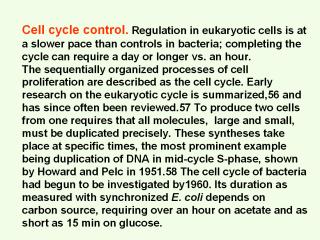| front |1 |2 |3 |4 |5 |6 |7 |8 |9 |10 |11 |12 |13 |14 |15 |16 |17 |18 |19 |20 |21 |22 |23 |24 |25 |26 |27 |28 |29 |30 |review |
 |
Several waves of
DNA initiation must take place between the successive divisions of rapidly
growing bacteria, because DNA replication in mid-cycle requires about an hour.59 Activities of enzymes increase periodically during the bacterial cycle.60 Controls are of course essential to regulate reactions both on and within the cell membrane. Formation of ATP by both glycolysis and by the Krebs citric acid cycle is closely coordinated by feedbacks of enzyme production and activity.61 As an early example, Krebs cycle intermediates do not accumulate as they are oxidized and smoothly pass through these many reactions. There must therefore be coordinating mechanisms. An early clue in 1948 suggests that a feedback from strong inhibition of succinic dehydrogenase by oxalacetate produced three reactions downstream. |